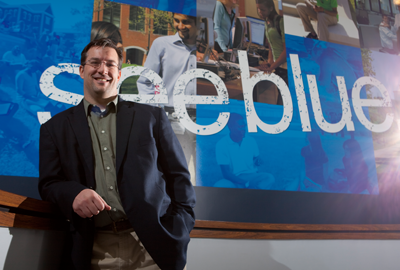Justin Wedeking's research shows following the norm can be detrimental to success in the Supreme Court
By Rebekah Tilley
photos by Mark Cornelison
When it comes to complex legal issues before the U.S. Supreme Court, it’s all about how you look at it. And as Dr. Justin Wedeking discovered, a fresh approach usually results in a winning case.
 In an article that will be published later this year in the prestigiousAmerican Journal of Political Science, the associate professor in the UK Department of Political Science found that when petitioners emphasized alternative ways of arguing about an issue before the Supreme Court, they increased their likelihood of success.
In an article that will be published later this year in the prestigiousAmerican Journal of Political Science, the associate professor in the UK Department of Political Science found that when petitioners emphasized alternative ways of arguing about an issue before the Supreme Court, they increased their likelihood of success.
>>Also quoted in NY Times on the hearings
>>Wedeking cited in NY Times article "Justices Are Long on Words but Short on Guidance"
Wedeking sampled 110 high profile cases that went before the U. S. Supreme Court between 1979-1989. “These cases all had nine or more amicus curiae briefs on them so they were pretty important to a lot of outside groups who were trying to make persuasive arguments one way or another to the Justices,” said Wedeking, explaining the selection process.
Out of these 110 cases, Wedeking developed a way to measure the “status quo frame” and language from the briefs that framed the issue in question in a unique way.
Despite lawyers being trained to emphasize alternative approaches when their original arguments fail, Wedeking found that only in one-third of cases were alternative frames used. The problem is if you haven’t mentioned alternative frames before making it to the Supreme Court, it’s pretty much too late.
“The argument suggests the petitioners should always be using the alternative frame,” said Wedeking. “But in reality, because the lower court frames the case in such a way, you may not have the luxury of plausibly making that claim because both parties are constrained by what was argued at the lower court level.”
Wedeking himself welds frames in his research. Political scientists who study voting behavior have long proved that framing a question differently will yield a different result from the voting public. In his research, Wedeking uses a political psychology frame on the U.S. Supreme Court.
Additionally, Wedeking takes a broader, more aggregate approach to the Court as an institution over a significant amount of time rather than studying the individual voting habits of small handful of Justices. So if you’re hoping to discover what Justice Sotomayor has for breakfast effects her votes on critical issues, you won’t find it here.
“Political scientists differ a little bit in how much we emphasize the idiosyncratic vs. the systematic differences,” Wedeking explained. “We tend to emphasize commonalities or system commonalities across all the Justices, while other approaches might emphasize the idiosyncratic nature of things that gave them a particular keen insight on an issue. We’re looking for generalized patterns.”
As Wedeking explains, it’s challenging to perform any sort of standard statistical test on nine people. And at the end of the day, the decisions that affect us are not ones made only by Justice Alito or Justice Breyer, but by a majority of the justices that represent the institution as a whole.
“It only really matters when five of them or more agree on something,” Wedeking said. “We really care about court outputs. It’s in the aggregate that we can really see how liberal or conservative a court is.”
At least, that’s how Wedeking looks at it.
